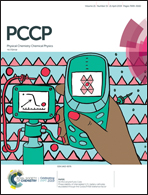On the involvement of d-electrons in superatomic shells: the group 3 and 4 transition metals†
Abstract
The geometries and electronic structures of small M7C (M = Sc, Y, La, Ti, Zr, Hf; C = 0, ±1, ±2) clusters have been calculated at a range of multiplicities at each cluster charge, using density functional theory methods. These clusters conform to the existing superatom model, with some contextual differences. There are a range of states which are populated by the outermost s and d-electrons of the constituent atoms, with an irregular Aufbau rule for the states formed from the atomic d-electrons. The states comprised of d-electrons present themselves as two states of P-symmetry and two states of F-symmetry, which are nearly degenerate, followed by states of D-symmetry, a shell ordering which arises due to the symmetry, and favourable overlap, of the contributing states. The effect of exact exchange in modulating the localisation of these states is also discussed. In addition, this study shows pseudo-superatomic states which arise due to the 5-fold symmetry of the clusters, materialising as either a ring or plane of electron density. In summary, these observations allow for an expansion of the role that early transition metals have within the existing superatom framework.



 Please wait while we load your content...
Please wait while we load your content...